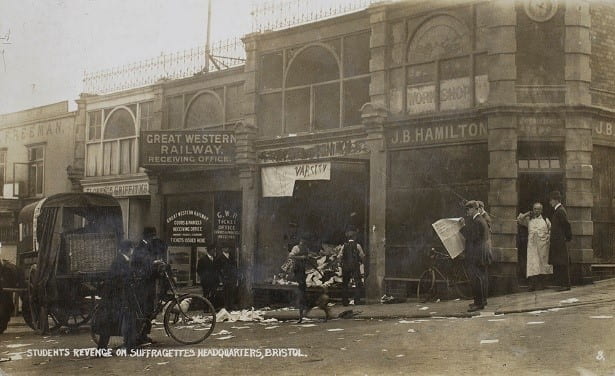With pre-season underway and the second half of the BUCS season just around the corner, History Graduate and Hospitality Assistant Joseph Sharp looks into the history of Coombe Dingle’s Sports Pavilion as it opens back up for the new term.
While working at Harry’s Bar, I investigated the history of the Pavilion itself given that I was studying History at the university. One of the most interesting chapters of the Pavilion’s history was connected to the suffragette movement.

The Pavilion was at one point a target for suffragette action, this action being the burning down of the building on 23 October 1913 as part of a wider campaign of resistance via the suffragettes. The context around the burning of this building is far more specific than a random act of arson though and speaks to growing tensions between male undergraduates and suffragettes in the city at the beginning of the 20th century over exclusionary university admission policies and general hostilities between the two groups.
We can see how tensions between students and suffragettes came to a head, with historians Byrne and Burlton highlighting this in their work ‘Bravo, Bristol! The City at War 1914-1918’. The suffragette presence in Bristol was established with the opening of a Bristol Branch of the Women’s Social and Political Union (WSPU) at 37 Queen’s Road in 1909 which served as a shop and office where fundraising drives and meetings would be held. Action from the WSPU involved an attack on Winston Churchill on 15 November 1909 by Theresa Garnett who repeatedly struck Churchill with a whip saying “Take that in the name of the insulted women in England”.

Further action by the Bristol suffragettes included attacking post-boxes and the burning of the university Sports Pavilion. The nature of the arson to the Pavilion was in retaliation for the imprisonment of Mary Richardson for setting fire to a house in Hampton-in-Thames. We know this as the note found at the site of arson read “Business before pleasure. Hobhouse being responsible will pay. Release Mary Richardson”. Here Hobhouse was the Liberal MP for Bristol East and was a staunch anti-suffragist.
In retaliation for the burning of the Sports Pavilion building, between 300-500 male students marched on the WSPU Bristol Branch on Queen’s Road on 25 October 1913 (just two days after the burning). These students wrecked the shop and burned literature and leaflets in the streets, while reports noted that the police stood by while this happened. Several photos commemorate this incident, such as the one below, where the visibility of a banner reading ‘Varsity’ implies that the undergraduates who marched upon the shop were members of sports teams at the university.

This concluded the skirmishes between students and suffragettes in Bristol prior to the war, all ignited by the burning of Coombe Dingle’s Sports Pavilion that is now home to Harry’s Bar and facilities that provide for sports teams at the university. Coombe Dingle as a site underwent a major refurbishment in 1999, courtesy of the National Lottery and other funding sources. The refurbishment saw the creation of the indoor facility with famous teams visiting the site, such as the Pakistan and Kenyan teams training here for the 1999 Cricket World Cup and the New Zealand All Blacks rugby team using the facilities on occasion.
It’s clear that the Sports Pavilion at Coombe Dingle was at one point a piece of history in a political conflict instrumental in the women’s suffragette movement, and even if as a target for arson it reveals to us the zeitgeist of this period and the tensions during this time.
I’d like to thank Arron at the Sport, Exercise and Health department and all of my colleagues at Coombe Dingle for being such a wonderful team (especially Nutch and Chef Tim, you guys are the best).

This is brilliant thanks for writing it Joe. We need a plaque up in the pavilion to make people aware of this history.